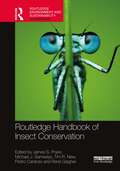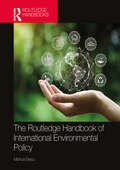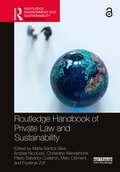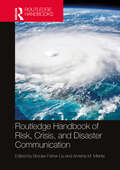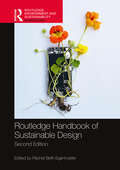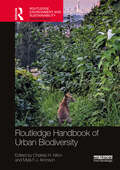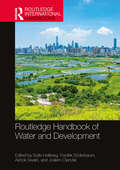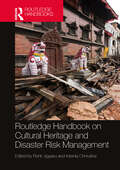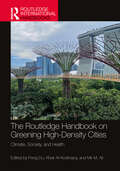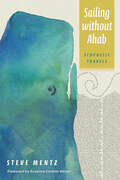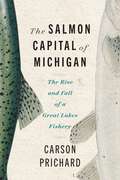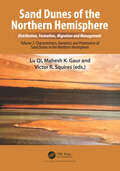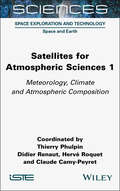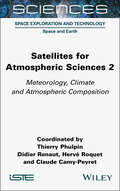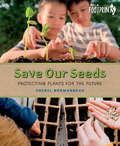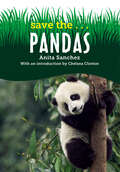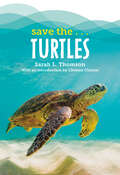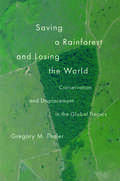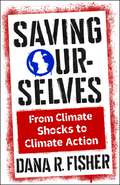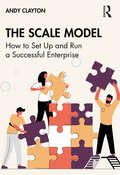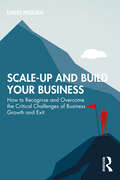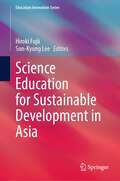- Table View
- List View
Routledge Handbook of Insect Conservation (Routledge Environment and Sustainability Handbooks)
by Tim R. New James S. Pryke Michael J. Samways Pedro Cardoso René GaigherThis handbook presents a comprehensive overview of insect conservation and provides practical solutions to counteract insect declines, at a time where insects are facing serious threats across the world from habitat destruction to invasive species and climate change.The Routledge Handbook of Insect Conservation consist of six sections, covering all aspects of insect conservation, containing contributions from academics, researchers and practitioners from across the globe. Section I addresses the fundamentals of insect conservation and outlines the reason why insects are important and discusses the greatest drivers of insect decline. The chapters in Section II examine the approaches that can be used for insect conservation globally, such as protected areas and agroecology, while highlighting the importance of insects in the composition and function of ecosystems. The chapters in Section III focus on insect populations in the major biomes around the world, from temperate and tropical forests to savannas and grasslands, with the chapters in Section IV focusing on natural and manmade ecosystems of the world, including mountain, soil, urban, island and agricultural habitats. They discuss the unique pressures and challenges for each biome and ecosystem and offer practical solutions for conserving their insect populations. Section V focuses on the assessment and monitoring of insects for conservation, discussing how we can implement practical monitoring protocols and what options are available. A wide variety of methods and tools are examined, including citizen science, bioindication, the role of taxonomy, drones and eDNA. The book concludes by examining policy and education strategies for insect conservation in Section VI. The chapters discuss key issues around social and policy strategies and conservation legislation for ensuring the long-term protection of insects.This book is essential reading for students and scholars of biodiversity conservation and entomology as well as professionals and policymakers involved in conservation looking for real-world solutions to the threats facing insects across the globe.
The Routledge Handbook of International Environmental Policy
by Mahua BasuThis handbook is a one-stop, comprehensive guide to global initiatives for climate action. It examines policies to tackle climate change and the critical role various organizations play.The volume: Includes in-depth discussion of individual issues related to the environment Highlights global initiatives, negotiations, and international organizations responsible for climate action, protecting marine and freshwater environment, protecting atmosphere and climate, conserving biological diversity, chemicals and wastes management, environmental governance, safeguarding against warfare and disasters Debates on-ground implications of the international policies for the Global South Brings together case studies from across the world Presents a toolkit for environment practitioners to seek sustainable and practicable solutions to problems Includes suggested readings for researchers Brings together primary documents, supportive illustrations, graphs, and maps The handbook will be an essential reference for scholars and researchers of environmental studies, environmental policy and governance, sustainability and resilience. It will also be indispensable for policy makers, think tanks and NGOs.
Routledge Handbook of Private Law and Sustainability (Routledge Environment and Sustainability Handbooks)
by Marta Santos Silva Andrea Nicolussi Christiane Wendehorst Pablo Salvador Coderch Marc Clément Fryderyk ZollThe Routledge Handbook of Private Law and Sustainability reflects on how the law can help tackle the current environmental challenges and make our societies more resilient to future crises.Sustainability has been high on the political agenda since the approval of the Sustainable Development Goals in 2015 and the EU Green Deal in 2019. The Green Agenda aims at making Europe the first climate‑neutral continent by 2050, but humanity persists in an ecological overshoot that puts at risk the survival of species, including that of our own. Drawing together a selection of leading thinkers in the field, this Handbook provides a curated overview of the most recent and relevant discussions for private lawyers related to environmental and sustainability concerns. The authors delve into case study examples from 20 countries in Europe and beyond and discuss a wide range of issues, including new property law and consumer law paradigms, the use of legal tech for promoting sustainable property management, strategies for fighting planned obsolescence, eco‑design, the servitisation economy, advances on corporate climate litigation and mandated green private sludges. Overall, the volume is designed to empower new generations of legal scholars to take an active role in the transition to a more sustainable future. It will also assist policymakers in producing better policy, through pinpointing the main legal issues that need to be addressed and offering a comparative overview of legal solutions and best practices.Divided into six key parts and overseen by a team of internationally recognised expert editors, this Handbook will be an essential resource for students, scholars, private lawyers and policymakers who wish to have a comprehensive, fundamental overview of how environmental sustainability concerns reflect on private law.
Routledge Handbook of Risk, Crisis, and Disaster Communication
by Brooke Fisher Liu Amisha M. MehtaThis Handbook provides a comprehensive overview of core concepts, research, and practice in risk, crisis, and disaster communication.With contributions from leading academic experts and practitioners from diverse disciplinary backgrounds including communication, disaster, and health, this Handbook offers a valuable synthesis of current knowledge and future directions for the field. It is divided into four parts. Part One begins with an introduction to foundational theories and pedagogies for risk and crisis communication. Part Two elucidates knowledge and gaps in communicating about climate and weather, focusing on community and corporate positions and considering text and visual communication with examples from the US and Australia. Part Three provides insights on communicating ongoing and novel risks, crises, and disasters from US and European perspectives, which cover how to define new risks and translate theories and methodologies so that their study can support important ongoing research and practice. Part Four delves into communicating with diverse publics and audiences with authors examining community, first responder, and employee perspectives within developed and developing countries to enhance our understanding and inspire ongoing research that is contextual, nuanced, and impactful. Offering innovative insights into ongoing and new topics, this handbook explores how the field of risk, crisis, and disaster communications can benefit from theory, technology, and practice.It will be of interest to students, researchers, and practitioners in the fields of disaster, emergency management, communication, geography, public policy, sociology, and other related interdisciplinary fields.
Routledge Handbook of Sustainable Design (Routledge Environment and Sustainability Handbooks)
by Rachel Beth EgenhoeferThe Routledge Handbook of Sustainable Design considers the design, not only of artifacts, but of structures, systems, and interactions in the context of sustaining our shared planet. This revised edition introduces new and updated chapters, as well as a new section on pedagogy for sustainable design. With authors from around the world, design is positioned in context with recent crises such as global pandemics, racial reckoning, political unrest, and natural disasters. Just as design is an interdisciplinary field, the climate crisis is deeply tangled in racial justice, gender justice, global health, economics, trade, and more. Divided into six sections, it presents a holistic approach to understanding the many facets of sustainable design: Part 1: Systems and Design Part 2: Complexities of Sustainable Design Part 3: Community Engaged Design for Local and Global Diversity Part 4: Design for Sustainable Behaviors Part 5: Design Futures Part 6: Pedagogy in Design for Sustainability Arguing that design needs to restore, regenerate, and rejuvenate our planet and people, this handbook will be invaluable to researchers, students, and practitioners across all subdisciplines of design, architecture, business, energy management, visual arts, and environmental studies, among others.
Routledge Handbook of Urban Biodiversity (Routledge Environment and Sustainability Handbooks)
by Charles Nilon Myla F.J. AronsonThis handbook provides a state-of-the-art, comprehensive overview of the expanding field of urban biodiversity. The field of urban biodiversity has emerged from within the broad discipline of urban ecology in the past two decades and is now a significant field in its own right. In view of this, the Routledge Handbook of Urban Biodiversity presents a thorough treatment of this field detailing the history of urban biodiversity, theoretical foundations, current state of knowledge, and application of that knowledge. The handbook is split into four parts: Part I: Setting the Stage for Urban Biodiversity Research and Practice Part II: Foundational Concepts and Theory in Urban Biodiversity Research Part III: Population and Community Ecology of Key Urban Taxa Part IV: Urban Biodiversity Practice: Management, Planning, and Design for Healthy Communities This volume contains interdisciplinary and global contributions from established and early career academics as well as professionals and practitioners, addressing two key fields in urban biodiversity: fundamental research focused on answering questions about the mechanisms explaining the distribution of species among and within cities; and applied research and work by practitioners to address concerns about urban biodiversity conservation, restoration, planning, design, and public involvement. This handbook is essential reading for students, academics, and professionals interested and working in the fields of urban biodiversity, ecology, nature conservation, urban planning, and landscape architecture.
Routledge Handbook of Water and Development (Routledge International Handbooks)
by Sofie Hellberg Fredrik Söderbaum Ashok Swain Joakim ÖjendalWater is essential for human life and at the centre of political, economic, and socio-cultural development. This Routledge Handbook of Water and Development offers a systematic, wide-ranging, and state-of-the-art guide to the diverse links between water and development across the globe. It is organized into four parts: Part I explores the most significant theories and approaches to the relationship between water and development. Part II consists of carefully selected in-depth case studies, revealing how water utilization and management are deeply intertwined with historical development paths and economic and socio-cultural structures. Part III analyses the role of governance in the management of water and development. Part IV covers the most urgent themes and issues pertaining to water and development in the contemporary world, ranging from climate change and water stress to agriculture and migration. The 32 chapters by leading experts are meant to stimulate researchers and students in a wide range of disciplines in the social and natural sciences, including Geography, Environmental Studies, Development Studies, and Political Science. The Handbook will also be of great value to policymakers and practitioners.
Routledge Handbook on Cultural Heritage and Disaster Risk Management
by Rohit Jigyasu Ksenia ChmutinaThis Handbook provides a comprehensive and interdisciplinary overview of the intersections between cultural heritage and disaster risks. It serves as a defining reference, presenting the key concepts and policy arena that disaster risk management and cultural heritage currently operate. With 22 contributions from leading scholars and practitioners in the field, chapters explore the various contexts for cultural heritage and disaster risk management, illustrated through case studies from around the world. The Handbook is organised into 4 parts: Part 1 includes Disaster Risk Management and Cultural Heritage, Part 2 helps to Understanding the context, Part 3 focuses on the challenges and Part 4 delves deep into the future prospects. This Handbook provides insights a wide range of topics and themes, such as climate change, conflict, urbanisation, the role of community, and examines the relationships with a range of sectors such as governance and policy, finance, infrastructure, shelter, and urban planning. It also presents critiques on issues that are often taken for granted, including technocratic approaches, nature/culture binary, the romanticisation of traditional knowledges and the role of recovery and reconstruction. Insights into the future are also presented, and the Handbook concludes with a detailed agenda of proposed action to be taken in the field. Offering critical reflections on the topic, this book caters to students, researchers, professionals, and policy makers in the fields of disaster studies, cultural studies, heritage studies, conservation and geography.
The Routledge Handbook on Greening High-Density Cities: Climate, Society and Health (Routledge International Handbooks)
by Kheir Al-Kodmany Peng Du Mir M. AliThis new handbook provides a platform to bring together multidisciplinary researchers focusing on greening high-density agglomerations from three perspectives: climate change, social implications, and people’s health. Written by leading scholars and experts, the chapters aim to summarize the “state-of-the-art” and produce a reference book for policymakers, practitioners, academics, and researchers to study, design, and build high-density cities by integrating green spaces. The topics covered in the book include (but are not limited to) Urban Heat Island, Green Space and Carbon Sequestration, Green Space and Social Equity, Green Space and Public Health, Biophilic Cities, Urban Agriculture, Vertical Farms, Urban Farming Technologies, Nature and Biodiversity, Nature and Health, Biophilic Design, Green Infrastructure, Urban Revitalization, Post-Covid Cities, Smart and Resilient Cities, Tall Buildings, and Sustainable Vertical Cities.
Sailing without Ahab: Ecopoetic Travels
by Steve MentzJourney through uncharted literary waters and explore Melville’s epic in bold new lightCome sail with I.We’re not taking the same trip, though you might recognize the familiar course. This time, the Pequod’s American voyage steers its course across the curvature of the Word Ocean without anyone at the helm. We are leaving one man and his madness on shore. Our ship overflows with glorious plurality—multiracial, visionary, queer, conflicted, polyphonic, playful, violent. But on this voyage something is different. Today we sail headless without any Captain. Instead of binding ourselves to the dismasted tyrant’s rage, the ship’s crew seeks only what we will find: currents teeming with life, a blue-watered alien globe, toothy cetacean smiles from vasty deeps. Treasures await those who sail without.This cycle of one hundred thirty-eight poems—one for each chapter in Moby-Dick, plus the Etymology, Extracts, and Epilogue—launches into oceanic chaos without the stabilizing mad focus of the Nantucket captain. Guided by waywardness and curiosity, these poems seek an alien ecopoetics of marine depths, the refraction of light, the taste of salt on skin. Directionless, these poems reach out to touch oceanic expanse and depth. It’s not an easy voyage, and not a certain one. It lures you forward. It has fixed its barbed hook in I.Sailing without means relinquishing goals, sleeping at the masthead, forgetting obsessions. I welcome you to trace wayward ways through these poems. Read them any way you can—back to front, at random, sideways, following the obscure promptings of your heart. It’s the turning that matters. It’s a blue wonder world that beckons.
The Salmon Capital of Michigan: The Rise and Fall of a Great Lakes Fishery (Great Lakes Books Series)
by Carson PrichardWeaving together the stories and voices of residents, anglers, community leaders, and environmental workers and researchers, this ethnographic account details the lives and livelihoods impacted by a once-unrivaled Michigan salmon fishery. From the introduction of Chinook salmon to the Great Lakes in the late 1960s, a thriving recreational fishery industry arose in Northern Michigan, attracting thousands of anglers to small towns like Rogers City each week at its peak. By the early 2000s, a crisis loomed beneath the surface of Lake Huron as the population of a prey fish species called alewife unexpectedly collapsed, depleting the salmon’s main source of food. By 2007, the salmon population had collapsed too, leaving local fisheries and their respective communities lacking a key commodity and a bid on fishery tourism. Author, angler, and ecologist Carson Prichard artfully incorporates fisheries science and local news media into an oral history that is entertaining, rich, and genuine. Complementing an ecological understanding of events, this narrative details the significance of the fishery and its loss as experienced by the townspeople whose lives it touched.
Sand Dunes of the Northern Hemisphere: Volume 2: Characteristics, Dynamics and Provenance of Sand Dunes in the Northern Hemisphere
by Lu Qi Mahesh K. Gaur Victor R. SquiresVolume 2 of the book ‘Sand Dunes of the Northern Hemisphere’ is sub-titled Characteristics, Dynamics and Provenance of Sand Dunes in the Northern Hemisphere. It brings together a vast body of information and insight into sand dune and desert systems from North Asia, Central Asia, North Africa and the Middle East. Chapters from the Russian Federation include studies on dune systems within the permafrost zone and there is a case study from temperate zone dune system in coastal Japan. Volume 2: Characteristics, Dynamics and Provenance of Sand Dunes in the Northern Hemisphere of 16 chapters in three Parts, focusses on Saharan Africa, Egypt, and Middle East and gives attention to sand mobility and encroachment with case studies from a number of countries where these matters are of concern. We also include chapters on the remote dunes in the permafrost zone and in the hyper-arid deserts of Iran. Case studies are used to highlight the characteristics of dunes and their interaction with humans in several widely divergent settings. Volume 2 concludes with some musing on the value of study of the past as key to the future and speculates on what the future might hold in the light of a warmer and drier Earth and a rise in sea level that threaten large tracts of low-lying land with marine incursions and destruction from storm surge. PART 4 Sand Mobility and Encroachment The seven chapters in this Part examine the real-world impact of sand encroachment and dune migration on people and their economic activities and the health, welfare and financial implications related to destruction of infrastructure, including human habitations. PART 5 Sand Dune Landscapes Distribution, Formation and Management Seven Case studies from several geographic regions in Africa, the Middle East, north-east Asia are presented here to demonstrate the underlying mechanisms in dune formation and the diverse approaches to their management. Human impacts such as sand mining, tourism development, combine with natural forces like climate variability to challenge the realization of an optimum management strategy. PART 6 Concluding Thoughts: Coping with an Unknown Future from a Little-known Past The two chapters in Part 6 have special roles. We are privileged to publish new research findings that are summarized here in Chapter 38 from extensive and detailed work conducted in the Kyzyl Kum, and Karakum sand seas of Central Asia. There is a strong belief that further study of the little-known past such as revealed in this study could unlock clues as to what a future Earth might look like. This leads on to speculation in Chapter 39 about the implications of what we already know about global change (not only climate change) and the impact of the Anthropocene on the dune systems, both inland and coastal. Sea level rise, marine incursions and an increase in extreme weather events will affect dune systems and sand seas on the Northern Hemisphere (and beyond).
Satellites for Atmospheric Sciences 1: Meteorology, Climate and Atmospheric Composition
by Thierry Phulpin Didier Renaut Hervé Roquet Claude Camy-PeyretHow can atmospheric variables such as temperature, wind, rain and ozone be measured by satellites? How are these measurements taken and what has been learned since the first measurements in the 1970s? What data are currently available and what data are expected in the future? The first volume of this encyclopedic book answers these questions by reporting the history of satellite meteorology and addresses how national and international agencies define coordinated programs to cover user needs. It also presents the principles of satellite remote sensing to deliver products suited to user requirements. This book is completed by a glossary and appendices with a list of supporting instruments already in use.
Satellites for Atmospheric Sciences 2: Meteorology, Climate and Atmospheric Composition
by Thierry Phulpin Didier Renaut Hervé Roquet Claude Camy-PeyretHow can atmospheric variables such as temperature, wind, rain and ozone be measured by satellites? How are these measurements taken and what has been learned since the first measurements in the 1970s? What data are currently available and what data are expected in the future? The second volume of this encyclopedic book presents each field of application – meteorology, atmospheric composition and climate – with its main aims as well as the specific areas which can be addressed through the use of satellite remote sensing. This book presents the satellite products used for operational purposes as well as those that allow for the advancement of scientific knowledge. The instruments that are at their origin are described, as well as the processing, delivery times and the knowledge they provide. This book is completed by a glossary and appendices with a list of supporting instruments already in use.
Save Our Seeds: Protecting Plants for the Future (Orca Footprints #31)
by Sheryl NormandeauKey Selling Points Learning about the importance of seeds and how to save and conserve them for the future is imperative to sustaining healthy life on the planet. Introduces young readers to STEM concepts, such as pollination, biodiversity, healthy ecosystems, food security, the climate crisis, GMO food and genetic engineering. Gives young readers the practical tools to take action to save seeds in their own lives and communities. The author is a certified master gardener and works with various gardening organizations in Alberta. She has a background in horticulture and urban agriculture and has written a number of nonfiction books for adults and kids.
Save the...Pandas (Save the...)
by Anita Sanchez Chelsea ClintonPandas have rolled and munched their ways into kids' hearts. With this book, readers can become panda experts and learn how to save the animals they love. Featuring an introduction from Chelsea Clinton!Did you know that pandas only live in the wild in China? How about that they are the only species of bear that eats almost nothing but plants? Or that pandas' black and white fur helps them hide in the shadows of their bamboo forests? Perfect for all animal lovers—and panda fans in particular—this book is filled with all the facts you need to know to become a panda expert! Where are pandas found? What's it like to be a panda? Why are pandas endangered, and who has been working hard to save them? Read this book and find out how you can help save the pandas!Complete with black-and-white photographs, a list of fun panda facts, and things that kids can do right this very moment to help save pandas from extinction, this book, with an introduction by animal advocate Chelsea Clinton, is a must for every family, school, and community library.
Save the...Turtles (Save the...)
by Sarah L. Thomson Chelsea ClintonTurtles have swum and snapped their ways into kids' hearts. With this book, readers can become turtle experts and learn how to save the animals they love. Featuring an introduction from Chelsea Clinton!Did you know that a turtle named Jonathan is the oldest known living animal on Earth? (He&’s almost two hundred!) How about that the largest sea turtles can dive more than three thousand feet below the water&’s surface? Or that turtles&’ shells have a spine in them, which makes turtles vertebrates—just like humans?Perfect for all animal lovers—and turtle fans in particular—this book is filled with all the facts you need to know to become a turtle expert! Where are turtles found? What&’s it like to be a turtle? Why are turtles endangered, and who has been working hard to save them? Read this book and find out how you can help save the turtles!Complete with black-and-white photographs, a list of fun turtle facts, and things that kids can do right this very moment to help save turtles from extinction, this book, with an introduction by animal advocate Chelsea Clinton, is a must for every family, school, and community library.
Saving a Rainforest and Losing the World: Conservation and Displacement in the Global Tropics (Yale Agrarian Studies Series)
by Gregory M. ThalerAn unflinching investigation of the false promises of land sparing, exposing how its illusory successes mask the failures of green capitalism For two decades, the concept of land sparing, the claim that agricultural intensification can spare land by preventing forest clearing for agricultural expansion, has dominated tropical forest conservation. Land sparing policies transform landscapes and livelihoods with the promise of reconciling agricultural development with environmental conservation. But that land sparing promise is false. Based on six years of research on agrarian frontiers in Indonesia, Brazil, and Bolivia, this book traces where and how land sparing becomes policy and charts the social and ecological effects of these political contests. Gregory M. Thaler explains why land sparing appears successful in some places but not in others and reveals that success as an illusion achieved by displacing deforestation to new frontiers. The failure of land sparing exposes a harsh truth behind assurances of green capitalism: capitalist development is ecocide.
Saving Ourselves: From Climate Shocks to Climate Action (Society and the Environment)
by Dana R. FisherWe've known for decades that climate change is an existential crisis. For just as long, we've seen the complete failure of our institutions to rise to the challenge. Governments have struggled to meet even modest goals. Fossil fuel interests maintain a stranglehold on political and economic power. Even though we have seen growing concern from everyday people, civil society has succeeded only in pressuring decision makers to adopt watered-down policies. All the while, the climate crisis worsens. Is there any hope of achieving the systemic change we need?Dana R. Fisher argues that there is a realistic path forward for climate action—but only through mass mobilization that responds to the growing severity and frequency of disastrous events. She assesses the current state of affairs and shows why public policy and private-sector efforts have been ineffective. Spurred by this lack of progress, climate activism has become increasingly confrontational. Fisher examines the radical flank of the climate movement: its emergence and growth, its use of direct action, and how it might evolve as the climate crisis worsens. She considers when and how activism is most successful, identifying the importance of creating community, capitalizing on shocking moments, and cultivating resilience. Clear-eyed yet optimistic, Saving Ourselves offers timely insights on how social movements can take power back from deeply entrenched interests and open windows of opportunity for transformative climate action.
The Scale Model: How to Set Up and Run a Successful Enterprise
by Andy ClaytonThe Scale Model does one thing: makes it easy for business entrepreneurs to grow their businesses. Using a proven methodology that is easy to understand and implement, business teams can learn how to diagnose and solve barriers to growth. The Scale Model equips CEOs and senior leaders with a framework to assess where the pain points lie in their business, and easy-to-use templates to help them work out the solutions to enable continued growth. The Model has been used by high-growth companies around the world to achieve industry-beating growth in sales and profits, with engaged and aligned teams. In a complicated business environment, the straightforward advice and practical structure of the Scale Model provides for business planning. When you're busy running your business, you want just one place to go to fix it. This is that place. Pick up The Scale Model today, work through the tools inside, and watch your business grow. That's how easy it is.
The Scale Model: How to Set Up and Run a Successful Enterprise
by Andy ClaytonThe Scale Model does one thing: makes it easy for business entrepreneurs to grow their businesses. Using a proven methodology that is easy to understand and implement, business teams can learn how to diagnose and solve barriers to growth.The Scale Model equips CEOs and senior leaders with a framework to assess where the pain points lie in their business, and easy-to-use templates to help them work out the solutions to enable continued growth. The Model has been used by high-growth companies around the world to achieve industry-beating growth in sales and profits, with engaged and aligned teams. In a complicated business environment, the straightforward advice and practical structure of the Scale Model provides for business planning.When you're busy running your business, you want just one place to go to fix it. This is that place. Pick up The Scale Model today, work through the tools inside, and watch your business grow. That's how easy it is.
Scale-up and Build Your Business: How to Recognise and Overcome the Critical Challenges of Business Growth and Exit
by David MolianHow do business founders not only start a business but ensure sustainable growth for the future? This book provides the tools and understanding that enable successful business growth at the scale-up stage. Scale-up and Build Your Business distils the author’s two decades of working with high-growth, high-performing independently owned and managed businesses, including Cobra Beer, Hotel Chocolat, Belvoir Cordials, Thatcher’s Cider, Pacific Direct and Go Ape. Over many years David Molian and his colleagues have identified both the drivers that accelerate growth and the blockers that prevent it. Through case histories, industry analyses and numerous examples this book details five key challenges faced by ambitious entrepreneurs, and documents how they overcome them. For each key challenge, this book describes the accelerators and bear traps which will help or hinder the journey to successful growth and the creation of long-term, sustainable, independent value that translates into successful exit. The lessons within this book will be invaluable for policymakers, advisors and ambitious business founders who want to turn a start-up into a successful and sustainable company. In a period marked by uncertainty and economic stagnation, this guide is more vital than ever.
Scale-up and Build Your Business: How to Recognise and Overcome the Critical Challenges of Business Growth and Exit
by David MolianHow do business founders not only start a business but ensure sustainable growth for the future? This book provides the tools and understanding that enable successful business growth at the scale-up stage.Scale-up and Build Your Business distils the author’s two decades of working with high-growth, high-performing independently owned and managed businesses, including Cobra Beer, Hotel Chocolat, Belvoir Cordials, Thatcher’s Cider, Pacific Direct and Go Ape. Over many years David Molian and his colleagues have identified both the drivers that accelerate growth and the blockers that prevent it. Through case histories, industry analyses and numerous examples this book details five key challenges faced by ambitious entrepreneurs, and documents how they overcome them. For each key challenge, this book describes the accelerators and bear traps which will help or hinder the journey to successful growth and the creation of long-term, sustainable, independent value that translates into successful exit.The lessons within this book will be invaluable for policymakers, advisors and ambitious business founders who want to turn a start-up into a successful and sustainable company. In a period marked by uncertainty and economic stagnation, this guide is more vital than ever.
Scattering Amplitudes in Quantum Field Theory (Lecture Notes in Physics #1021)
by Simon Badger Johannes Henn Jan Christoph Plefka Simone ZoiaThis open access book bridges a gap between introductory Quantum Field Theory (QFT) courses and state-of-the-art research in scattering amplitudes. It covers the path from basic definitions of QFT to amplitudes, which are relevant for processes in the Standard Model of particle physics. The book begins with a concise yet self-contained introduction to QFT, including perturbative quantum gravity. It then presents modern methods for calculating scattering amplitudes, focusing on tree-level amplitudes, loop-level integrands and loop integration techniques. These methods help to reveal intriguing relations between gauge and gravity amplitudes and are of increasing importance for obtaining high-precision predictions for collider experiments, such as those at the Large Hadron Collider, as well as for foundational mathematical physics studies in QFT, including recent applications to gravitational wave physics.These course-tested lecture notes include numerous exercises with solutions. Requiring only minimal knowledge of QFT, they are well-suited for MSc and PhD students as a preparation for research projects in theoretical particle physics. They can be used as a one-semester graduate level course, or as a self-study guide for researchers interested in fundamental aspects of quantum field theory.
Science Education for Sustainable Development in Asia (Education Innovation Series)
by Hiroki Fujii Sun-Kyung LeeThis book presents an Asian perspective on transformative science education in the context of the United Nations' Sustainable Development Goals (SDGs). The chapters are written by contributors who practiced science education for sustainability in a research project entitled “Teacher Education for ESD in the Asia-Pacific Region” from 2017 to 2019, supported by the Japan Society for the Promotion of Science, and the Japanese National Commission for UNESCO. The book showcases the contributors’ innovations in science education for sustainability, presenting case studies of science teaching and learning, science curriculum and assessment, science education in collaboration with local communities, and science teacher education. Embodying Asian sustainability education paradigms, policies, and practices, these case studies depict the diversity and uniqueness of natural, social, and cultural contexts in Asia, while demonstrating their commonalities. Through examining these case studies, this book aims to provide examples for praxis, and prospects, for new science classes, curricula, and teacher education in implementing education for sustainable development.
